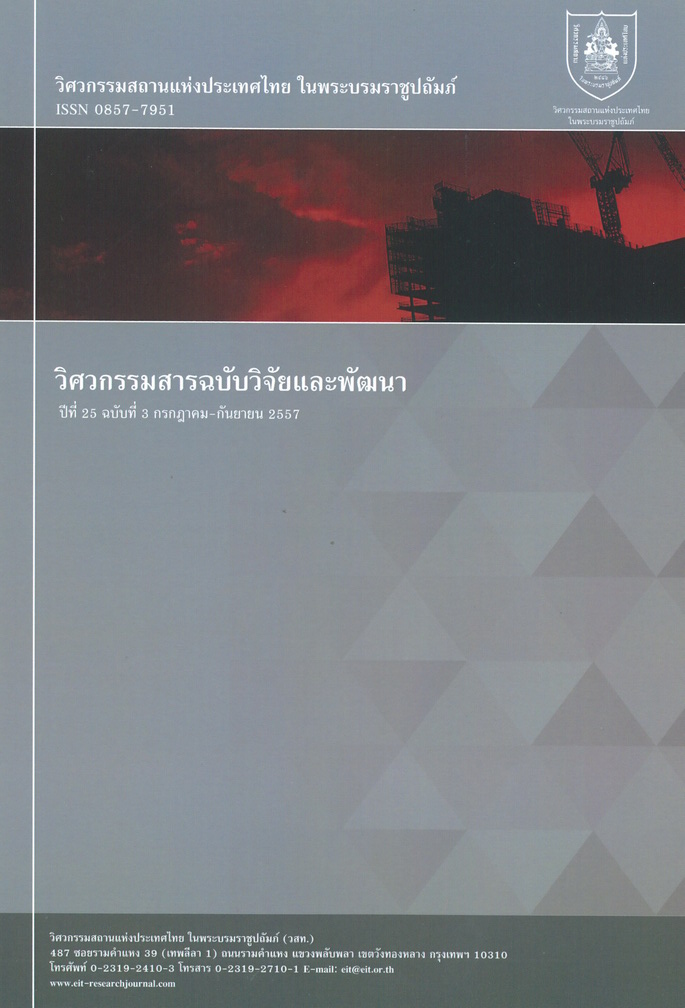INFLUENCE OF SHEAR WAVE VELOCITY MODEL OF SUBSOILS ON SEISMIC SITE EFFECTS
Main Article Content
Abstract
งานวิจัยนี้มีวัตถุประสงค์เพื่อศึกษาผลของการจำลองคุณสมบัติของชั้นดินต่อลักษณะการขยายกำลังของคลื่นแผ่นดินไหว โดยการจำลองชั้นดินที่มีพารามิเตอร์หลักคือความเร็วคลื่นเฉือนตามความลึกของชั้นดิน เนื่องจากเป็นค่าที่มีผลต่อพฤติกรรมด้านการขยายคลื่น คาบการสั่นหลัก และระยะเวลาของการสั่นสะเทือนของพื้นเนื่องจากแผ่นดินไหว แบบจำลองของชั้นดินสร้างจากข้อมูลการสำรวจความเร็วคลื่นเฉือนที่เคยมีการศึกษาในพื้นที่ กทม. และจากงานวิจัยก่อนหน้า ผลการศึกษาแสดงในรูปของความเร่งตอบสนองเชิงสเปกตรัมเนื่องจากคลื่นแผ่นดินไหวตัวอย่าง และวิจารณ์ผลในด้านการขยายคลื่นและคาบการสั่นหลัก โดยพบว่ากำลังขยายสูงสุดคือประมาณ 6 เท่าเกิดขึ้นที่คาบการสั่นประมาณ 1.0 วินาทีในแบบจำลองของชั้นดินด้วยระดับความลึกชั้นหินประมาณ 160 ถึง 300 เมตร ส่วนแบบจำลองที่ชั้นหินมีความลึกมากประมาณ 400 ถึง 700 เมตร มีผลของกำลังขยายสูงในช่วงคาบยาวประมาณ 2 ถึง 3 วินาทีอยู่ด้วย และมีการเปรียบเทียบผลจากการวิเคราะห์กับข้อมูลที่ตรวจวัดได้จากเหตุการณ์แผ่นดินไหวซึ่งพบความสอดคล้องดีของผลเมื่อใช้แบบจำลองระดับความลึกชั้นหินประมาณ 400 เมตร ที่สถานีตรวจวัด
This research aims to study the effects of subsoil models on modification of ground motions induced from seismic waves. The parameter for examination is shear wave velocity profile with depth at the site since it is the most influential parameter which governs characteristics of amplification, dominant period and duration of shaking. The models of subsoil were constructed based on recent investigations of shear wave velocity in Bangkok and previous researches. The acceleration response spectral resulted from a set of earthquake waves were presented and examined for their characteristics of amplification and dominant period. The amplification factor of about 6 was found around the period of 1.0 second for the model of 160 to 300 m depth of bedrock. For deeper bedrock model, 400 to 700 m, amplifications in long period ranges of 2 to 3 second were significantly observed. Comparison of results from the analysis and the observed record was made and their good agreement was achieved when using the model of 400 m depth bedrock at the seismometer station.
Article Details
The published articles are copyright of the Engineering Journal of Research and Development, The Engineering Institute of Thailand Under H.M. The King's Patronage (EIT).

